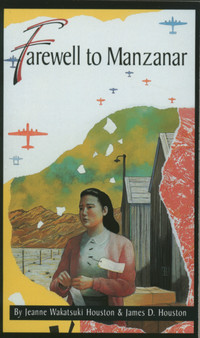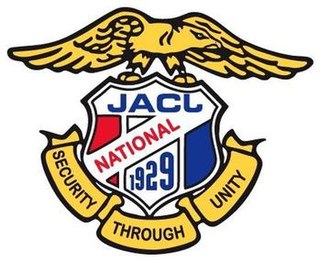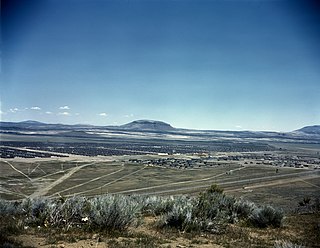Related Research Articles

During World War II, the United States, by order of President Franklin D. Roosevelt, forcibly relocated and incarcerated at least 125,284 people of Japanese descent in 75 identified incarceration sites. Most lived on the Pacific Coast, in concentration camps in the western interior of the country. Approximately two-thirds of the inmates were United States citizens. These actions were initiated by Executive Order 9066 following Imperial Japan's attack on Pearl Harbor. Like many Americans at the time, the architects of the removal policy failed to distinguish between Japanese immigrants and Japanese Americans. Of the 127,000 Japanese Americans who were living in the continental United States at the time of the Pearl Harbor attack, 112,000 resided on the West Coast. About 80,000 were Nisei and Sansei. The rest were Issei immigrants born in Japan who were ineligible for U.S. citizenship under U.S. law.

The War Relocation Authority (WRA) was a United States government agency established to handle the internment of Japanese Americans during World War II. It also operated the Fort Ontario Emergency Refugee Shelter in Oswego, New York, which was the only refugee camp set up in the United States for refugees from Europe. The agency was created by Executive Order 9102 on March 18, 1942, by President Franklin D. Roosevelt, and was terminated June 26, 1946, by order of President Harry S. Truman.

Farewell to Manzanar is a memoir published in 1973 by Jeanne Wakatsuki Houston and James D. Houston. The book describes the experiences of Jeanne Wakatsuki and her family before, during, and following their relocation to the Manzanar internment camp due to the United States government's internment of Japanese Americans during World War II. It was adapted into a made-for-TV movie in 1976 starring Yuki Shimoda, Nobu McCarthy, James Saito, Pat Morita, and Mako.

The Japanese American Citizens League is an Asian American civil rights charity, headquartered in San Francisco, with regional chapters across the United States.

The Tule Lake National Monument in Modoc and Siskiyou counties in California, consists primarily of the site of the Tule Lake War Relocation Center, one of ten concentration camps constructed in 1942 by the United States government to incarcerate Japanese Americans forcibly removed from their homes on the West Coast. They totaled nearly 120,000 people, more than two-thirds of whom were United States citizens. Among the inmates, the notation "鶴嶺湖" was sometimes applied.

The Amache National Historic Site, formally the Granada War Relocation Center but known to the internees as Camp Amache, was a concentration camp for Japanese Americans in Prowers County, Colorado. Following the Japanese attack on Pearl Harbor on December 7, 1941, Japanese Americans on the West Coast were rounded up and sent to remote camps. Among the inmates, the notation "亜町" was sometimes applied.

The Topaz War Relocation Center, also known as the Central Utah Relocation Center (Topaz) and briefly as the Abraham Relocation Center, was an American concentration camp in which Americans of Japanese descent and immigrants who had come to the United States from Japan, called Nikkei were incarcerated. President Franklin Roosevelt signed Executive Order 9066 in February 1942, ordering people of Japanese ancestry to be incarcerated in what were euphemistically called "relocation centers" like Topaz during World War II. Most of the people incarcerated at Topaz came from the Tanforan Assembly Center and previously lived in the San Francisco Bay Area. The camp was opened in September 1942 and closed in October 1945.

No-No Boy is a 1957 novel, and the only novel published by the Japanese American writer John Okada. It tells the story of a Japanese-American in the aftermath of the internment of Japanese Americans during World War II. Set in Seattle, Washington, in 1946, the novel is written in the voice of an omniscient narrator who frequently blends into the voice of the protagonist.

The Poston Internment Camp, located in Yuma County in southwestern Arizona, was the largest of the 10 American concentration camps operated by the War Relocation Authority during World War II.

The Jerome War Relocation Center was a Japanese American internment camp located in southeastern Arkansas, near the town of Jerome in the Arkansas Delta. Open from October 6, 1942, until June 30, 1944, it was the last American concentration camp to open and the first to close. At one point it held as many as 8,497 detainees. After closing, it was converted into a holding camp for German prisoners of war. Today, few remains of the camp are visible, as the wooden buildings were taken down. The smokestack from the hospital incinerator still stands.
Hisaye Yamamoto was an American author known for the short story collection Seventeen Syllables and Other Stories, first published in 1988. Her work confronts issues of the Japanese immigrant experience in America, the disconnect between first and second-generation immigrants, as well as the difficult role of women in society.

Monica Sone, born Kazuko Itoi, was a Japanese American writer, best known for her 1953 autobiographical memoir Nisei Daughter, which tells of the Japanese American experience in Seattle during the 1920s and 1930s and in the World War II internment camps, and is an important text in Asian American and Women's Studies courses.
Tsuyako "Sox" Kitashima was a Japanese-American activist noted for her role in seeking reparations for Japanese American internment by the United States government during World War II, particularly as investigated by the Commission on Wartime Relocation and Internment of Civilians in the 1980s.
Mitsuye "Maureen" Endo Tsutsumi was an American woman of Japanese descent who was placed in an internment camp during World War II. Endo filed a writ of habeas corpus that ultimately led to a United States Supreme Court ruling that the U.S. government could not continue to detain a citizen who was "concededly loyal" to the United States.
Chizuko Judy Sugita de Queiroz is an American artist and art educator; her paintings depict her memories of a childhood during the Japanese American internment.

Sakaye Shigekawa was an American physician who specialized in obstetrics. Born to Japanese-American parents, she was imprisoned and forced to live and work at an internment camp in California, providing medical care to fellow Japanese-American internees during World War II. She completed her training in Chicago before returning to Los Angeles in 1948, where she practiced for more than 50 years.
Toyo Suyemoto was a Japanese-American poet, memoirist, and librarian.
The Japanese American Evacuation and Resettlement Study (JERS) was a research project funded by the War Relocation Authority (WRA), an agency responsible for overseeing the relocation of Japanese Americans, The University of California, the Giannini Foundation, the Columbian Foundation, and the Rockefeller Foundation with the total amount of funding reaching almost 100,000 U.S. dollars. It was conducted by a team of social scientists at the University of California, Berkeley. The team was led by sociologist Dorothy Swaine Thomas, a Lecturer in Sociology for the Giannini Foundation and a professor of rural sociology, and included anthropologists John Collier Jr. and Alexander Leighton, among others. The study combined each of the major social sciences such as sociology, social anthropology, political science, social psychology, and economics to effectively illustrate the effects of internment on Japanese Americans. The terminology of "relocation" can be confusing: The WRA termed the forced removal of Japanese Americans from the West Coast an "evacuation" and called the incarceration of these people in the ten camps as "relocation." Later it also applied the term "relocation" to the program that enabled the evacuees to leave the camps (provided they had been certified as loyal.

Esther Takei Nishio was an American woman from California, incarcerated at the Granada War Relocation Center in Colorado during World War II. She was the first Japanese-American student to enroll in a California university after returning from camp, in 1944, when she was chosen as a test case for resettlement.
Mary "Molly" Teiko Oyama Mittwer (1907–1994) was a Japanese American journalist and community organizer who is best known for covering controversial topics such as social reform, dating and marriage, racism and integration. Throughout the 1930s and 1940s, Oyama Mittwer wrote articles to help fellow Nisei Japanese Americans navigate the political and social complexities of the day and to promote multiracial and cross-cultural solidarity among activists of different racial and ethnic backgrounds. She wrote advice columns, articles, interviews, and poetry for major Japanese-American newspapers and journals, including but not limited Rafu Shimpo, Kashu Mainichi, Nichibei,Shin-Sekai, The New World Sun, Leaves, Gyo-Sho, Nisei magazine Current Life, and the Common Ground journal, which focused on giving minoritized racial groups a platform.
References
- ↑ "Japanese American Internee Data File: Yuriko Nakai". National Archives and Records Administration . Retrieved 2019-08-18.
- ↑ Lily Yuriko Nakai Havye, Foreword by Cherstin Lyon, Gasa Gasa Girl Goes To Camp, The University of Utah Press, 2014, p. x
- ↑ Weist, Ellen (October 17, 2014), "Salt Lake artist paints internment camp story with artistic eye", The Salt Lake Tribune
- ↑ Havey, Lily Yuriko Nakai; Lyon, Cherstin M. (2014). Gasa Gasa Girl Goes to Camp: A Nisei Youth Behind a World War II Fence. University of Utah Press. ISBN 978-1607813439.
- ↑ Lily Yuriko Nakai Havye, Gasa Gasa Girl Goes To Camp, The University of Utah Press, 2014, p. 22